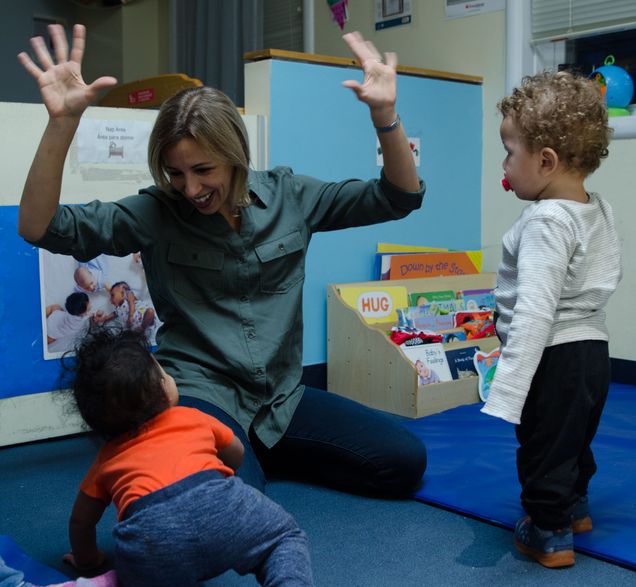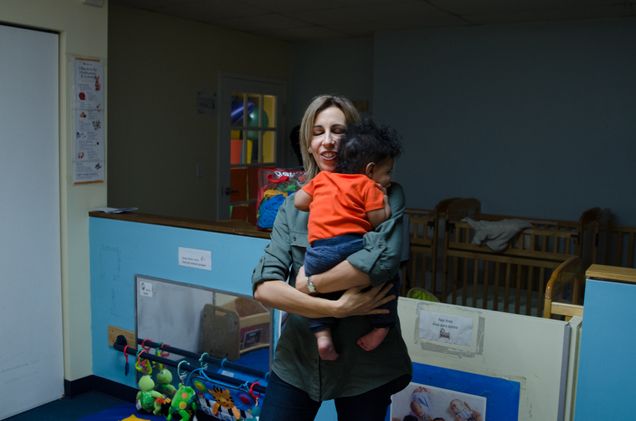#BUandBoston: Diana Dansereau & Horizons for Homeless Children
By: Douglas Darrah
From the outside, the Dorchester location of Horizons for Homeless Children looks like every other monolithic brick building in Boston. On the inside, it is warm, colorfully decorated, and full of life. They are, as their website states, “ramping up the fun.” They work to ensure that “every homeless child will have the opportunity to learn, play, and thrive.” Music education plays a key role in that mission. Diana Dansereau, a professor in BU’s College of Fine Arts, helps Horizons fulfill that need.

Most of the infants she works with are between 3 and 12 months. At that age, children can already recognize familiar songs and are learning to sing and move to music. According to an article that she recently wrote, “early engagement with music can set the foundation for a life of music making.” Dansereau also explains that “children can communicate musically well before they communicate with language,” so this early engagement allows the teachers and her to meaningfully connect with the children and know them in new ways.
The children love working with her. They smile and laugh as she greets them with a song. “Hello, hello, how are you today?” she sings in her clear, warm, soprano. “Hello, hello, it’s time to sing and play.”
Once the pleasantries are finished, she sings about their hands and feet. “Hello, hello, hands, how are you today? Hello, hello, hands, it’s time to sing and play.” She gently holds their half dollar sized extremities with her thumb and forefinger.
Gestures and movement play a key role in their group singing. Dansereau connects with the children by sitting on their level and reaching out towards them with her palms up. Sometimes, she will sing a high note, “daaaa,” and raise her hands up into the air. Then she will lower her hands and sing a lower note, “dum”. While she is singing phrases, she moves her hands in a circular motion that reflects the song’s musical qualities.
Interspersed among the singing is some basic practice with rhythm. Dansereau chants “bum bum bum bum bum baaa, bum bum bum ba bum” while she slaps out the rhythm on her thigh. One boy tries to replicate it by beating bean bags together. The other children stare at her with a mixture of awe and amusement.
Eventually, they start to play more complex games. They toss around bean bags while singing “daaaa” and “dum” whenever they go up and come down respectively. One boy, predictably, tries to put a bean bag into his mouth.
To finish, they play peek-a-boo with translucent, rainbow colored cloths. Dansereau raises one above a child’s head and sings, “daaaa”. Then she lets it drop, “dum”. As it covers his head, he rips it away. He smiles and they repeat it. Then, they reverse roles, and he drapes the cloth over her head. When he pulls it away and realizes that she has been under there the whole time, they both laugh.
Dansereau states that encouraging this type of interaction is one of the goals of her program: “I strive to prompt as many serve-and-return interactions as possible. I ‘serve’ to the infants by initiating musical engagement. The infants will ‘return’ or respond in some way when they are ready, and I will then acknowledge, interpret, and reply to their return. Hopefully, the musical conversation continues and develops.”
Such interactions are believed to be key ingredients for brain development. In addition, they help equip children with necessary interpersonal skills and encourage expression and musical growth. It is important, to both Dansereau and Horizons, that children not be denied that opportunity because they are experiencing homelessness.
By five o’clock, parents are gradually coming in and picking up their children. Dansereau is eventually left with only one infant – a girl who is nodding off. She holds her in her arms and slowly walks around the room, singing all the while.

This post is part of our #BUandBoston series, highlighting the work and research of BU students, faculty, and staff throughout the City of Boston. Interested in having your Boston-related work featured? Tag us on Instagram or Twitter @BUonCities using the #BUandBoston or send us an email at ioc@bu.edu.